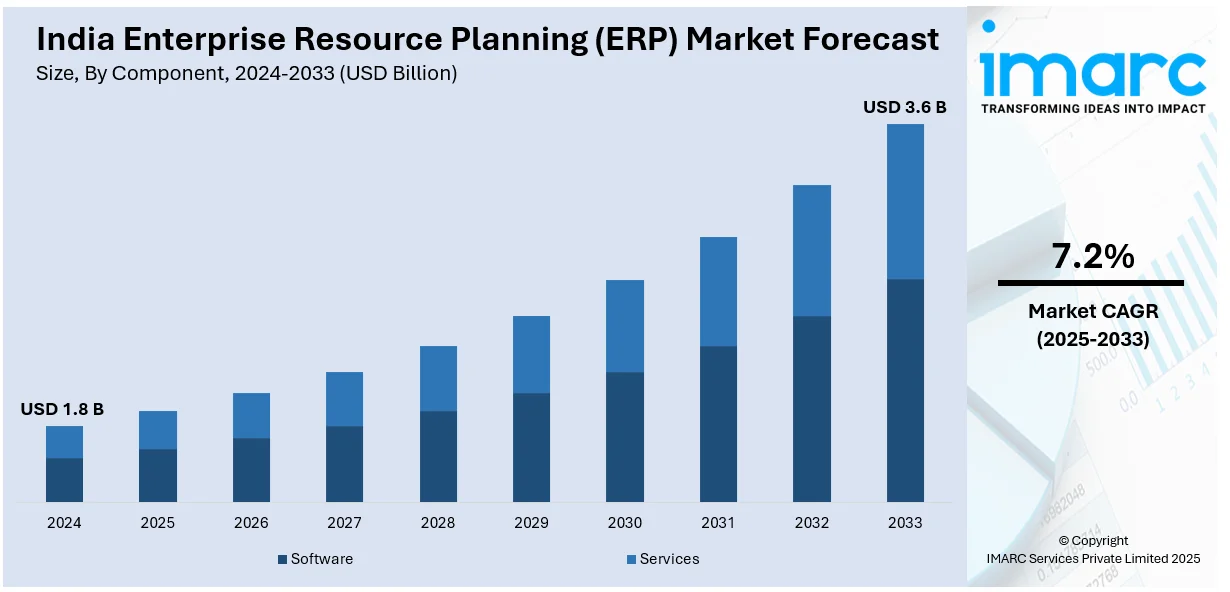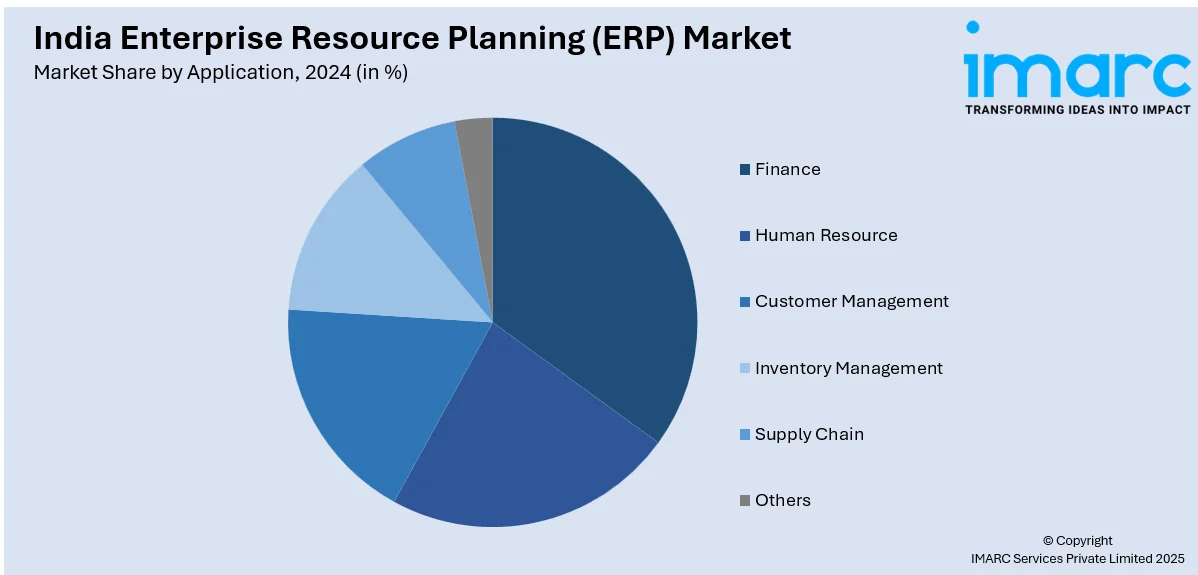
India Enterprise Resource Planning (ERP) Market Size, Share, Trends and Forecast by Component, Deployment Type, Application, End User, and Region, 2025-2033
India Enterprise Resource Planning (ERP) Market Overview:
The India enterprise resource planning (ERP) market size reached USD 1.8 Billion in 2024. Looking forward, IMARC Group expects the market to reach USD 3.6 Billion by 2033, exhibiting a growth rate (CAGR) of 7.2% during 2025-2033. The market is expanding as businesses shift to cloud-based systems and adopt AI-driven automation. Growing digitalization, demand for real-time data insights, and government initiatives promoting enterprise technology adoption are key drivers favoring the market's development across various industries.
|
Report Attribute
|
Key Statistics
|
|---|---|
|
Base Year
|
2024
|
|
Forecast Years
|
2025-2033
|
|
Historical Years
|
2019-2024
|
| Market Size in 2024 | USD 1.8 Billion |
| Market Forecast in 2033 | USD 3.6 Billion |
| Market Growth Rate (2025-2033) | 7.2% |
India Enterprise Resource Planning (ERP) Market Trends:
ERP Adoption in India's Export Sector
The growing emphasis on digital transformation in India’s export industry is driving the adoption of ERP solutions. With increasing global trade, businesses need efficient systems to manage export-related operations, ensure compliance, and streamline financial processes. The implementation of ERP in this sector is enhancing transparency, minimizing operational delays, and improving overall productivity. As Indian exporters face challenges related to documentation, policy management, and claims processing, an integrated digital system is essential for boosting efficiency and reducing risks. Aligned with this trend, in October 2024, India’s commerce ministry launched an ERP portal under ECGC to streamline export services for pharma exporters. This platform enhances claims processing, policy management, and grievance redressal, accelerating digital adoption in ERP solutions and improving efficiency, transparency, and financial security in India's export sector. The introduction of this ERP system reflects the government’s commitment to modernizing trade operations. By providing an end-to-end digital infrastructure, it helps exporters manage transactions with greater accuracy. This move is expected to encourage other industries to integrate ERP solutions, strengthening India’s position in global trade. The expansion of ERP in export services will likely drive demand for advanced software solutions, further fueling market growth.

To get more information on this market, Request Sample
ERP Integration in Educational Institutions
Educational institutions in India are rapidly adopting ERP solutions to streamline operations, improve communication, and enhance administrative efficiency. With rising student enrollments and complex data management needs, schools require a centralized system for tracking student records, managing admissions, and coordinating academic activities. The demand for ERP solutions in education is increasing as institutions recognize the benefits of automation in handling administrative tasks. For instance, in July 2024, The Navy Education Society launched an integrated ERP system for Naval Schools in Delhi and Visakhapatnam. This initiative standardizes processes, centralizes data, and enhances real-time stakeholder communication, driving ERP adoption in India's education sector and improving digital transformation in institutional management. This development highlights the shift toward technology-driven education management. By integrating ERP, schools can ensure seamless student data migration, reduce paperwork, and improve collaboration among administrators, teachers, students, and parents. The move also reflects a broader trend of digitization in education, encouraging other institutions to invest in ERP for better operational efficiency. As more schools and universities implement ERP solutions, the Indian market for education-focused ERP systems is set to grow significantly.
India Enterprise Resource Planning (ERP) Market Segmentation:
IMARC Group provides an analysis of the key trends in each segment of the market, along with forecasts at the region/country level for 2025-2033. Our report has categorized the market based on component, deployment type, application, and end user.
Component Insights:
- Software
- Services
The report has provided a detailed breakup and analysis of the market based on the component. This includes software and services.
Deployment Type Insights:
- On-Premises
- Cloud
The report has provided a detailed breakup and analysis of the market based on the deployment type. This includes on-premises and cloud.
Application Insights:

- Finance
- Human Resource
- Customer Management
- Inventory Management
- Supply Chain
- Others
A detailed breakup and analysis of the market based on the application have also been provided in the report. This includes finance, human resource, customer management, inventory management, supply chain, and others.
End User Insights:
- Manufacturing
- BFSI
- Healthcare
- Retail
- Government and Utilities
- IT and Telecom
- Others
A detailed breakup and analysis of the market based on the end user have also been provided in the report. This includes manufacturing, BFSI, healthcare, retail, government and utilities, it and telecom, and others.
Regional Insights:
- North India
- South India
- East India
- West India
The report has also provided a comprehensive analysis of all the major regional markets, which include North India, South India, East India, and West India.
Competitive Landscape:
The market research report has also provided a comprehensive analysis of the competitive landscape. Competitive analysis such as market structure, key player positioning, top winning strategies, competitive dashboard, and company evaluation quadrant has been covered in the report. Also, detailed profiles of all major companies have been provided.
India Enterprise Resource Planning (ERP) Market News:
- February 2025: NetSuite expanded its cloud ERP services in India by launching data centers in Mumbai and Hyderabad. This strengthens local data security, enhances system performance, and accelerates cloud ERP adoption, supporting SMBs and enterprises in streamlining financial management, automation, and regulatory compliance.
- July 2024: Eton Solutions launched its cloud-based ERP platform, AtlasFive, for family offices in India. Catamaran, Infosys founder Narayana Murthy’s family office, adopted the platform to streamline investment management. This development strengthens ERP adoption in wealth management, boosting industry demand for advanced financial planning and compliance solutions.
India Enterprise Resource Planning (ERP) Market Report Coverage:
| Report Features | Details |
|---|---|
| Base Year of the Analysis | 2024 |
| Historical Period | 2019-2024 |
| Forecast Period | 2025-2033 |
| Units | Billion USD |
| Scope of the Report |
Exploration of Historical Trends and Market Outlook, Industry Catalysts and Challenges, Segment-Wise Historical and Future Market Assessment:
|
| Components Covered | Software, Services |
| Deployment Types Covered | On-Premises, Cloud |
| Applications Covered | Finance, Human Resource, Customer Management, Inventory Management, Supply Chain, Others |
| End Users Covered | Manufacturing, BFSI, Healthcare, Retail, Government and Utilities, IT and Telecom, Others |
| Regions Covered | North India, South India, East India, West India |
| Customization Scope | 10% Free Customization |
| Post-Sale Analyst Support | 10-12 Weeks |
| Delivery Format | PDF and Excel through Email (We can also provide the editable version of the report in PPT/Word format on special request) |
Key Benefits for Stakeholders:
- IMARC’s industry report offers a comprehensive quantitative analysis of various market segments, historical and current market trends, market forecasts, and dynamics of the India enterprise resource planning (ERP) market from 2019-2033.
- The research report provides the latest information on the market drivers, challenges, and opportunities in the India enterprise resource planning (ERP) market.
- Porter's five forces analysis assist stakeholders in assessing the impact of new entrants, competitive rivalry, supplier power, buyer power, and the threat of substitution. It helps stakeholders to analyze the level of competition within the India enterprise resource planning (ERP) industry and its attractiveness.
- Competitive landscape allows stakeholders to understand their competitive environment and provides an insight into the current positions of key players in the market.
Key Questions Answered in This Report
The enterprise resource planning (ERP) market in India was valued at USD 1.8 Billion in 2024.
The India enterprise resource planning (ERP) market is projected to exhibit a CAGR of 7.2% during 2025-2033, reaching a value of USD 3.6 Billion by 2033.
The enterprise resource planning (ERP) in India is growing owing to the increasing need for businesses to streamline operations, improve efficiency, and ensure better data management. Factors such as digital transformation, cloud adoption, and growing awareness about the benefits of ERP are contributing to the market growth. The demand for real-time data analytics and scalability also fuels ERP implementation across industries.
Need more help?
- Speak to our experienced analysts for insights on the current market scenarios.
- Include additional segments and countries to customize the report as per your requirement.
- Gain an unparalleled competitive advantage in your domain by understanding how to utilize the report and positively impacting your operations and revenue.
- For further assistance, please connect with our analysts.
 Request Customization
Request Customization
 Speak to an Analyst
Speak to an Analyst
 Request Brochure
Request Brochure
 Inquire Before Buying
Inquire Before Buying




.webp)




.webp)












